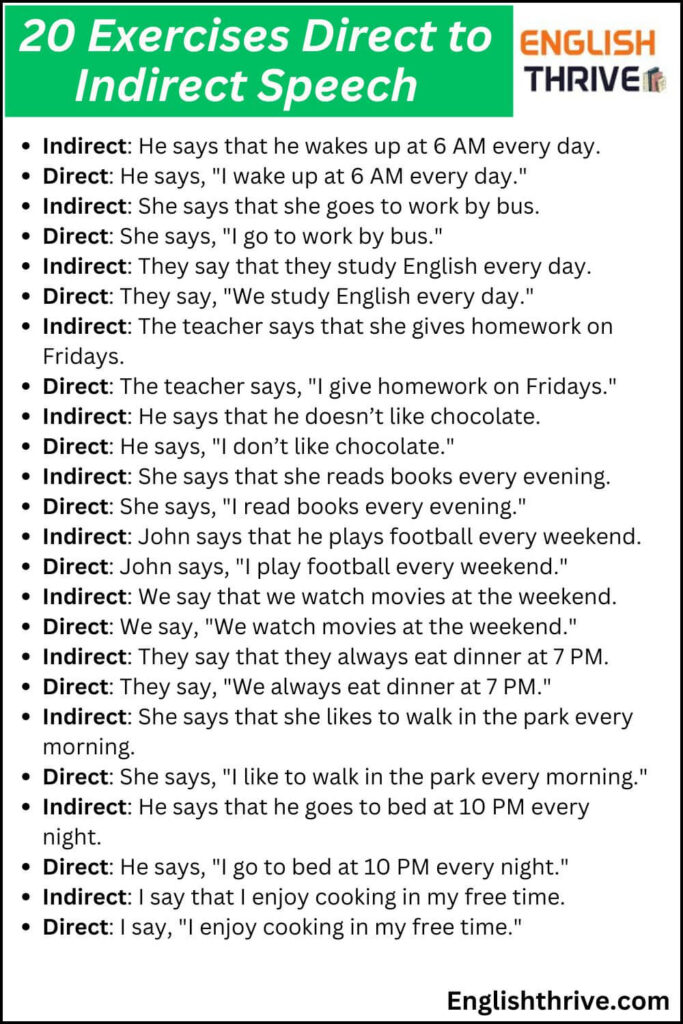Understanding the simple present tense in narration can feel like learning the foundation of a language. It’s the basic building block that helps bring stories to life in a smooth, natural way. Whether you’re narrating a day at work, telling a joke, or recounting a memory, the simple present tense keeps things grounded in the present moment. It’s a powerful tool for making your words direct and clear. Let’s explore some easy examples and uncover how to use the simple present tense effectively in storytelling.
What is the Simple Present Tense?
The simple present tense is used to describe actions that are habitual, regular, or facts that are universally true. Think of it as the “go-to” tense for talking about things that happen repeatedly or things that are currently happening as a general truth. It’s not flashy, but it’s reliable and foundational to any good narration.
For example, when you’re telling a friend about your daily routine, you’ll say something like, “I wake up at 7 AM every day.” It’s an action you do regularly, so the simple present tense works perfectly here.
Everyday of Simple Present Tense in Narration
Now, let’s imagine you’re telling a friend about your morning. Here’s how you might use the simple present tense in Narration:
“I wake up at 7 AM, make myself a cup of coffee, and check my emails.”
Notice how it’s simple, clear, and expresses actions that you do every day. There’s no need for any extra detail or complex tenses. The beauty of the simple present is that it conveys the routine of life without making it sound complicated.
This same pattern works when you’re sharing something more general or factual, like explaining your favorite hobby:
“I love playing soccer. I practice every Saturday with my team.”
You’re simply narrating your passion, and by using the simple present tense, you make it sound natural and engaging.
Using Simple Present in Storytelling
Let’s take this up a notch. Say you’re telling a story about something that happened at work:
“Every Monday, I meet with my team. We discuss the goals for the week, and I assign tasks.”
You’re using the simple present to describe routine actions, making your story feel more immediate. The reader feels like they’re right there with you, in the present moment, experiencing it alongside you.
In stories, this tense can also help establish the setting. If you want to describe a place, the simple present is perfect:
“The coffee shop is always busy at noon. People come in, order their drinks, and sit at the window, typing away on their laptops.”
The beauty of this is that it gives your narrative a steady rhythm. It doesn’t get bogged down with the past or future. It’s as if you’re painting a picture of something that happens every day, in the here and now.
When to Use the Simple Present Tense
While we can use it to describe actions, habits, and facts, the simple present tense is also ideal for making general statements or observations. Here’s an example:
“Water boils at 100°C.”
This isn’t something we’re doing in the moment, but it’s a timeless fact, which the simple present tense captures perfectly. It’s like saying “this is how the world works.” It’s universal, and the simple present keeps it straightforward.
Simple Present Tense in Dialogue
When narrating a story, dialogue is a big part of creating a dynamic scene. The simple present tense is often used in dialogue, especially when characters are discussing everyday things or reacting to something in real-time. Here’s an example:
Person 1: “I’m so tired today.” Person 2: “Yeah, I feel the same. We should grab some coffee.”
Notice how the characters are using the simple present to share their immediate feelings. This is an easy, natural way to keep the conversation flowing.
Why It Works in Storytelling
The simple present tense is effective because it keeps things simple and easy to follow. Whether you’re narrating your daily routine, telling a funny incident, or describing a scene, it helps the audience stay grounded in the moment. And that’s the key to making your narration feel more authentic and less like a history lesson.
20 Exercises Direct to Indirect Speech (Simple Present Tense)
- Direct: He says, “I eat breakfast at 7 AM.”
- Indirect: He says that he eats breakfast at 7 AM.
- Direct: She says, “I work from Monday to Friday.”
- Indirect: She says that she works from Monday to Friday.
- Direct: John says, “I go to the gym every morning.”
- Indirect: John says that he goes to the gym every morning.
- Direct: They say, “We study English every day.”
- Indirect: They say that they study English every day.
- Direct: The teacher says, “I give assignments on Fridays.”
- Indirect: The teacher says that she gives assignments on Fridays.
- Direct: She says, “I love reading books.”
- Indirect: She says that she loves reading books.
- Direct: He says, “I don’t like coffee.”
- Indirect: He says that he doesn’t like coffee.
- Direct: We say, “We visit our grandparents every month.”
- Indirect: We say that we visit our grandparents every month.
- Direct: They say, “We play football every weekend.”
- Indirect: They say that they play football every weekend.
- Direct: She says, “I am always on time for meetings.”
- Indirect: She says that she is always on time for meetings.
- Direct: He says, “I need help with this task.”
- Indirect: He says that he needs help with this task.
- Direct: They say, “We watch movies on weekends.”
- Indirect: They say that they watch movies on weekends.
- Direct: I say, “I take a walk every evening.”
- Indirect: I say that I take a walk every evening.
- Direct: She says, “I attend yoga classes twice a week.”
- Indirect: She says that she attends yoga classes twice a week.
- Direct: He says, “I don’t understand the problem.”
- Indirect: He says that he doesn’t understand the problem.
- Direct: She says, “I love traveling.”
- Indirect: She says that she loves traveling.
- Direct: They say, “We have lunch at 12 PM every day.”
- Indirect: They say that they have lunch at 12 PM every day.
- Direct: John says, “I drive to work every day.”
- Indirect: John says that he drives to work every day.
- Direct: He says, “I always take the bus to school.”
- Indirect: He says that he always takes the bus to school.
- Direct: She says, “I study at the library after school.”
- Indirect: She says that she studies at the library after school.

20 Exercises Indirect to Direct Speech (Simple Present Tense in Narration)
- Indirect: He says that he wakes up at 6 AM every day.
- Direct: He says, “I wake up at 6 AM every day.”
- Indirect: She says that she goes to work by bus.
- Direct: She says, “I go to work by bus.”
- Indirect: They say that they study English every day.
- Direct: They say, “We study English every day.”
- Indirect: The teacher says that she gives homework on Fridays.
- Direct: The teacher says, “I give homework on Fridays.”
- Indirect: He says that he doesn’t like chocolate.
- Direct: He says, “I don’t like chocolate.”
- Indirect: She says that she reads books every evening.
- Direct: She says, “I read books every evening.”
- Indirect: John says that he plays football every weekend.
- Direct: John says, “I play football every weekend.”
- Indirect: We say that we watch movies at the weekend.
- Direct: We say, “We watch movies at the weekend.”
- Indirect: They say that they always eat dinner at 7 PM.
- Direct: They say, “We always eat dinner at 7 PM.”
- Indirect: She says that she likes to walk in the park every morning.
- Direct: She says, “I like to walk in the park every morning.”
- Indirect: He says that he goes to bed at 10 PM every night.
- Direct: He says, “I go to bed at 10 PM every night.”
- Indirect: I say that I enjoy cooking in my free time.
- Direct: I say, “I enjoy cooking in my free time.”
- Indirect: They say that they always arrive early at work.
- Direct: They say, “We always arrive early at work.”
- Indirect: She says that she enjoys traveling during the holidays.
- Direct: She says, “I enjoy traveling during the holidays.”
- Indirect: He says that he plays the guitar in the evenings.
- Direct: He says, “I play the guitar in the evenings.”
- Indirect: John says that he reads the newspaper every morning.
- Direct: John says, “I read the newspaper every morning.”
- Indirect: She says that she takes the bus to work every day.
- Direct: She says, “I take the bus to work every day.”
- Indirect: They say that they do yoga every morning.
- Direct: They say, “We do yoga every morning.”
- Indirect: I say that I drink coffee every morning.
- Direct: I say, “I drink coffee every morning.”
- Indirect: He says that he always eats lunch at noon.
- Direct: He says, “I always eat lunch at noon.”
Mastering the Simple Present Tense in Narration
The simple present tense is your friend when you want to tell a story or describe something that happens regularly. It’s simple, direct, and always in the here and now. So the next time you’re telling a story, try using the simple present tense for actions that are habitual, regular, or universally true. You’ll notice how much more fluid and relatable your storytelling becomes.

